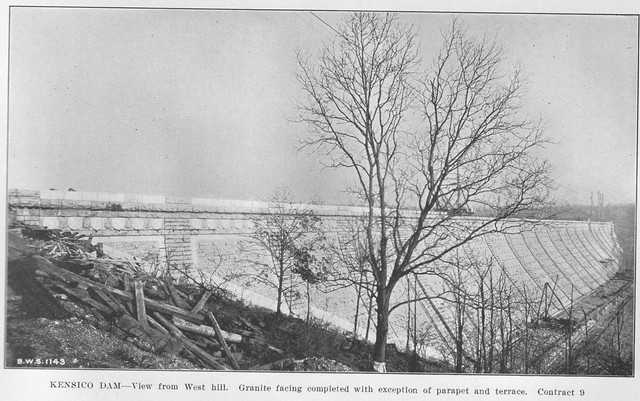
Home > NYC Reports > 1915
The face of the dam is nearly finished in this picture. It looks like just the parapet walls (top railings) need to be completed. During 1915, the remaining 11% of masonry had been set, the stone facing had been placed, the upper pavilions were 80% complete, and the parapet walls were under construction. Placement of the stone facing began in March and completed in December. Stones and other materials were brought to the front of the dam below the terrace by railroad and then hoisted into position.
The granite facing is added to the dam on the underlying steps visible on the right side of the photo. On the top of the dam, the top stones for the parapet walls have not yet been placed.
The reservoir side of the dam likely just before water was allowed to begin to fill the reservoir. The dam appears nearly complete on this side. Before filling, earth was placed on the back side of the dam up to elevation 220, leaving 150 feet above ground and a water depth of 135 feet. On the front and sides of the dam, 39,000 cubic yards of fill was placed in previously excavated areas, and 12 inches of topsoil was added to most areas in front of the dam. Just east of the dam, much work was completed during the year on the three-arch Kensico Bridge. The west abutment and pier were excavated, the false works for the arches constructed, and the stones placed and masonry poured.
While the weir was complete, the building housing the gates that control whether the water flows into the by-pass aqueduct or reservoir was still under construction in 1915. The reservoir was filling when the picture was taken, with 300 million gallons of water entering the reservoir daily. The reservoir was allowed to begin to fill on November 22nd (3 years ahead of schedule) and by the end of the year the water was 100 feet deep at the dam. During filling, the Bronx-Rye Tunnel under the peninsula was closed. The temporary reservoir (New Rye Lake) was maintained to the east of the peninsula so water to the Bronx could be delivered uninterrupted until they were ready to switch to using the main reservoir. As the aqueduct water rose behind the Bronx Dike, it eventually spilled over the waste weir and into the new reservoir. Some water was also delivered to the reservoir by passing through the by-pass aqueduct and then entering through the effluent (normally the outflow). This was done primarily to remove debris from the effluent. To prepare for the planned flooding, the final clearing of all tree stumps and roots was completed. Also all cesspools, vaults, drains, and barnyards were cleaned out and treated or burned out.
On January 13th, the Rye Pipeline carrying water from New Rye Lake to the Bronx Conduit was moved to connect to the Upper Gate Chamber of the dam, allowing the water to more closely follow its eventual path to the Bronx. Camp Kensico in front of the dam housed as many as 653 people during the year, with an additional 495 laborers working on the dam but living outside the camp. Road construction continued during the year, with the main road in front of the dam (now called Broadway) paved and opened to traffic. Other roads in the plaza and around the dam saw grading, some paving, and some placement of guardrails.
Home | 1914 Report | 1916 Report | Site Map
Synopsis written by Robert Mortell, 2013.